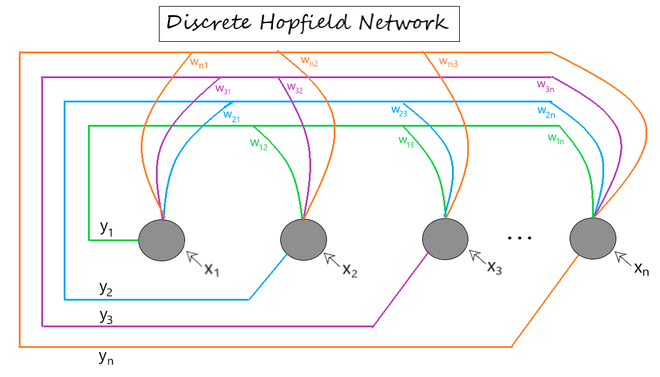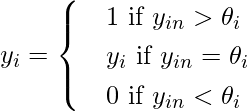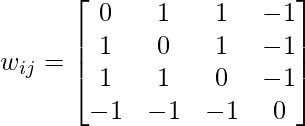霍普菲尔德神经网络
先决条件: RNN
由 John J. Hopfield 博士发明的 Hopfield 神经网络由一层“n”个完全连接的循环神经元组成。它通常用于执行自动关联和优化任务。它是使用收敛的交互过程计算的,它产生与我们普通神经网络不同的响应。
离散 Hopfield 网络:它是一个完全互连的神经网络,其中每个单元都连接到其他每个单元。它以离散方式运行,即它提供有限的不同输出,通常有两种类型:
- 二进制 (0/1)
- 双极 (-1/1)
与该网络相关的权重本质上是对称的,并具有以下特性。
结构与架构
- 每个神经元都有一个反相和一个非反相输出。
- 在完全连接的情况下,每个神经元的输出是所有其他神经元的输入,而不是自身。
图 1显示了具有以下元素的离散 Hopfield 神经网络架构的示例表示。

图 1:离散 Hopfield 网络架构
[ x1 , x2 , ... , xn ] -> Input to the n given neurons.
[ y1 , y2 , ... , yn ] -> Output obtained from the n given neurons
Wij -> weight associated with the connection between the ith and the jth neuron.训练算法
为了存储一组输入模式 S(p) [p = 1 到 P],其中S(p) = S 1 (p) … S i (p) … S n (p) ,权重矩阵由下式给出:
- 对于二进制模式
- 对于双极模式
(即这里的权重没有自连接)
涉及步骤
Step 1 - Initialize weights (wij) to store patterns (using training algorithm).Step 2 - For each input vector yi, perform steps 3-7.Step 3 - Make initial activators of the network equal to the external input vector x. ![]()
Step 4 - For each vector yi, perform steps 5-7. Step 5 - Calculate the total input of the network yin using the equation given below.![]()
Step 6 - Apply activation over the total input to calculate the output as per the equation given below: 
(其中θ i (阈值)通常取为 0)
Step 7 - Now feedback the obtained output yi to all other units. Thus, the activation vectors are updated.Step 8 - Test the network for convergence.示例问题
考虑以下问题。我们需要创建具有输入向量双极表示的离散 Hopfield 网络,因为 [1 1 1 -1] 或 [1 1 1 0](在二进制表示的情况下)存储在网络中。使用存储向量的第一个和第二个分量(即 [0 0 1 0])中缺失的条目测试 hopfield 网络。
分步解决方案
Step 1 - given input vector, x = [1 1 1 -1] (bipolar) and we initialize the weight matrix (wij) as:![由 QuickLaTeX.com 渲染 w_{ij} = \sum [s^T(p)t(p)] \\ = \begin{bmatrix} 1 \\ 1 \\ 1 \\ -1 \end{bmatrix} \begin{bmatrix} 1 & 1 & 1 & -1 \end{bmatrix} \\ = \begin{bmatrix} 1 & 1 & 1 & -1 \\ 1 & 1 & 1 & -1 \\ 1 & 1 & 1 & -1 \\ -1 & -1 & -1 & 1 \\\end{bmatrix}](https://mangodoc.oss-cn-beijing.aliyuncs.com/geek8geeks/Hopfield_Neural_Network_7.jpg)
and weight matrix with no self connection is:
Step 3 - As per the question, input vector x with missing entries, x = [0 0 1 0] ([x1 x2 x3 x4]) (binary)
- Make yi = x = [0 0 1 0] ([y1 y2 y3 y4])Step 4 - Choosing unit yi (order doesn't matter) for updating its activation.
- Take the ith column of the weight matrix for calculation.
(we will do the next steps for all values of yi and check if there is convergence or not) '
now for next unit, we will take updated value via feedback. (i.e. y = [1 0 1 0]) now for next unit, we will take updated value via feedback. (i.e. y = [1 0 1 0])![由 QuickLaTeX.com 渲染 y_{in_{4}} = x_4 + \sum_{j = 1}^4 [y_j w_{j4}] \\ = 0\ + \begin{bmatrix} 1 & 0 & 1 & 0 \end{bmatrix} \begin{bmatrix} -1 \\ -1 \\ -1 \\ 0 \end{bmatrix} \\ = 0\ + (-1)\ + (-1) \\ = -2 \\ Applying\ activation,\ y_{in_4} < 0 \implies y_4= 0 \\ giving\ feedback\ to\ other\ units,\ we\ get \\ y = \begin{bmatrix} 1 & 0 & 1 & 0 \end{bmatrix} \\ which\ is\ not\ equal\ to\ input\ vector\ \\ x = \begin{bmatrix} 1 & 1 & 1 & 0 \end{bmatrix} \\ Hence,\ no\ covergence.](https://mangodoc.oss-cn-beijing.aliyuncs.com/geek8geeks/Hopfield_Neural_Network_11.jpg)
now for next unit, we will take updated value via feedback. (i.e. y = [1 0 1 0])连续跳场网络:与离散跳场网络不同,这里的时间参数被视为连续变量。因此,我们可以获得介于 0 和 1 之间的值,而不是获得二进制/双极输出。它可用于解决约束优化和关联内存问题。输出定义为:
where,
vi = output from the continuous hopfield network
ui = internal activity of a node in continuous hopfield network.能量函数
跳场网络具有与之相关的能量函数。每次迭代后,它在更新(反馈)时要么减少要么保持不变。连续跳场网络的能量函数定义为:
![]()
为了确定网络是否会收敛到稳定配置,我们通过以下方式查看能量函数达到最小值:
如果每个神经元的活动时间由以下微分方程给出,则网络一定会收敛:
![]()